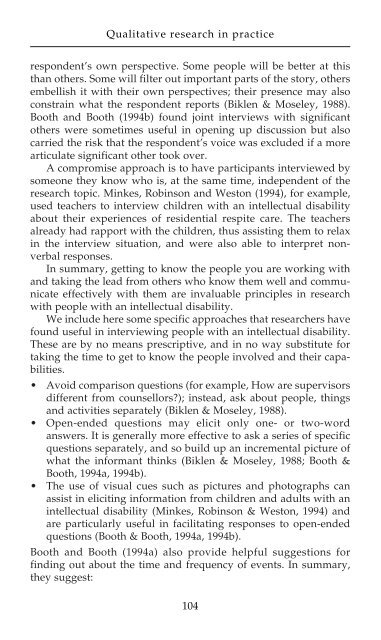Qualitative Research in Practice : Stories From the Field - Blogs Unpad
Qualitative Research in Practice : Stories From the Field - Blogs Unpad
Qualitative Research in Practice : Stories From the Field - Blogs Unpad
Create successful ePaper yourself
Turn your PDF publications into a flip-book with our unique Google optimized e-Paper software.
<strong>Qualitative</strong> research <strong>in</strong> practice<br />
respondent’s own perspective. Some people will be better at this<br />
than o<strong>the</strong>rs. Some will filter out important parts of <strong>the</strong> story, o<strong>the</strong>rs<br />
embellish it with <strong>the</strong>ir own perspectives; <strong>the</strong>ir presence may also<br />
constra<strong>in</strong> what <strong>the</strong> respondent reports (Biklen & Moseley, 1988).<br />
Booth and Booth (1994b) found jo<strong>in</strong>t <strong>in</strong>terviews with significant<br />
o<strong>the</strong>rs were sometimes useful <strong>in</strong> open<strong>in</strong>g up discussion but also<br />
carried <strong>the</strong> risk that <strong>the</strong> respondent’s voice was excluded if a more<br />
articulate significant o<strong>the</strong>r took over.<br />
A compromise approach is to have participants <strong>in</strong>terviewed by<br />
someone <strong>the</strong>y know who is, at <strong>the</strong> same time, <strong>in</strong>dependent of <strong>the</strong><br />
research topic. M<strong>in</strong>kes, Rob<strong>in</strong>son and Weston (1994), for example,<br />
used teachers to <strong>in</strong>terview children with an <strong>in</strong>tellectual disability<br />
about <strong>the</strong>ir experiences of residential respite care. The teachers<br />
already had rapport with <strong>the</strong> children, thus assist<strong>in</strong>g <strong>the</strong>m to relax<br />
<strong>in</strong> <strong>the</strong> <strong>in</strong>terview situation, and were also able to <strong>in</strong>terpret nonverbal<br />
responses.<br />
In summary, gett<strong>in</strong>g to know <strong>the</strong> people you are work<strong>in</strong>g with<br />
and tak<strong>in</strong>g <strong>the</strong> lead from o<strong>the</strong>rs who know <strong>the</strong>m well and communicate<br />
effectively with <strong>the</strong>m are <strong>in</strong>valuable pr<strong>in</strong>ciples <strong>in</strong> research<br />
with people with an <strong>in</strong>tellectual disability.<br />
We <strong>in</strong>clude here some specific approaches that researchers have<br />
found useful <strong>in</strong> <strong>in</strong>terview<strong>in</strong>g people with an <strong>in</strong>tellectual disability.<br />
These are by no means prescriptive, and <strong>in</strong> no way substitute for<br />
tak<strong>in</strong>g <strong>the</strong> time to get to know <strong>the</strong> people <strong>in</strong>volved and <strong>the</strong>ir capabilities.<br />
• Avoid comparison questions (for example, How are supervisors<br />
different from counsellors?); <strong>in</strong>stead, ask about people, th<strong>in</strong>gs<br />
and activities separately (Biklen & Moseley, 1988).<br />
• Open-ended questions may elicit only one- or two-word<br />
answers. It is generally more effective to ask a series of specific<br />
questions separately, and so build up an <strong>in</strong>cremental picture of<br />
what <strong>the</strong> <strong>in</strong>formant th<strong>in</strong>ks (Biklen & Moseley, 1988; Booth &<br />
Booth, 1994a, 1994b).<br />
• The use of visual cues such as pictures and photographs can<br />
assist <strong>in</strong> elicit<strong>in</strong>g <strong>in</strong>formation from children and adults with an<br />
<strong>in</strong>tellectual disability (M<strong>in</strong>kes, Rob<strong>in</strong>son & Weston, 1994) and<br />
are particularly useful <strong>in</strong> facilitat<strong>in</strong>g responses to open-ended<br />
questions (Booth & Booth, 1994a, 1994b).<br />
Booth and Booth (1994a) also provide helpful suggestions for<br />
f<strong>in</strong>d<strong>in</strong>g out about <strong>the</strong> time and frequency of events. In summary,<br />
<strong>the</strong>y suggest:<br />
104

















